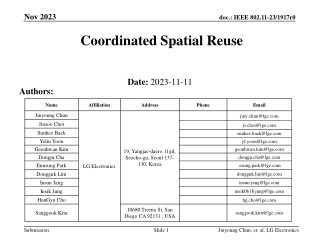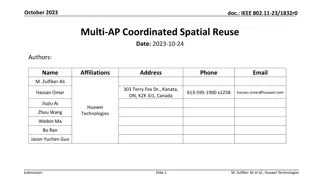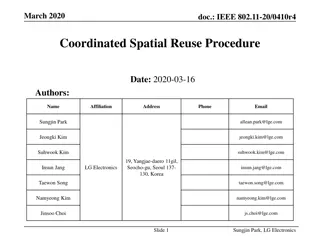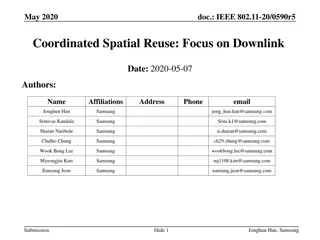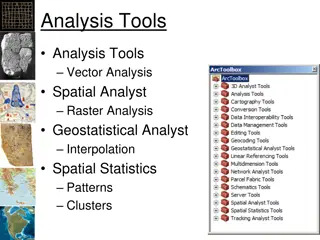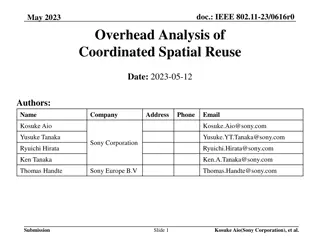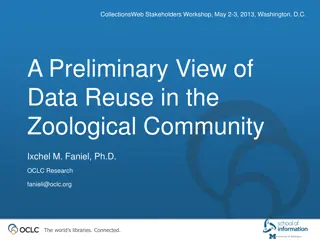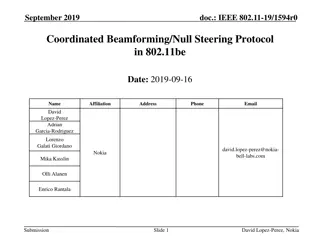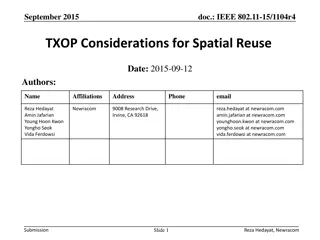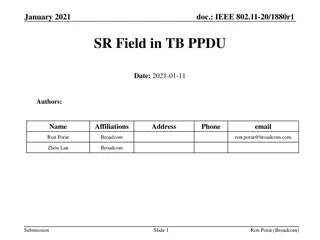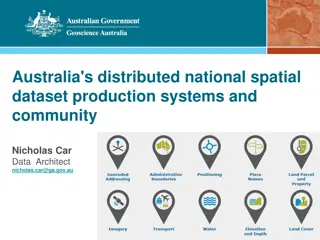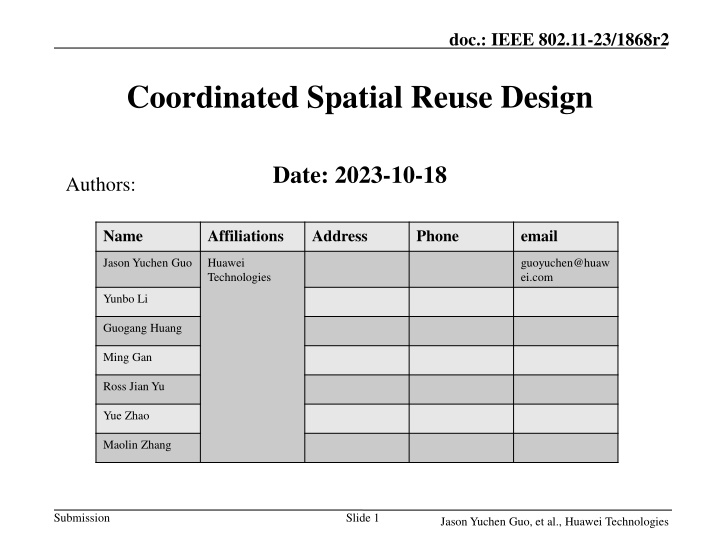
IEEE 802.11-23/1868r2 Coordinated Spatial Reuse Design Details
Explore the detailed design of Coordinated Spatial Reuse (CSR) in IEEE 802.11-23/1868r2 standard, covering setup procedures, parameters, and coordination schemes like Joint transmission and Coordinated Beamforming. Understand the benefits of CSR for throughput and latency gains in multi-AP environments.
Download Presentation

Please find below an Image/Link to download the presentation.
The content on the website is provided AS IS for your information and personal use only. It may not be sold, licensed, or shared on other websites without obtaining consent from the author. If you encounter any issues during the download, it is possible that the publisher has removed the file from their server.
You are allowed to download the files provided on this website for personal or commercial use, subject to the condition that they are used lawfully. All files are the property of their respective owners.
The content on the website is provided AS IS for your information and personal use only. It may not be sold, licensed, or shared on other websites without obtaining consent from the author.
E N D
Presentation Transcript
doc.: IEEE 802.11-23/1868r2 Coordinated Spatial Reuse Design Date: 2023-10-18 Authors: Name Affiliations Address Phone email Jason Yuchen Guo Huawei Technologies guoyuchen@huaw ei.com Yunbo Li Guogang Huang Ming Gan Ross Jian Yu Yue Zhao Maolin Zhang Submission Slide 1 Jason Yuchen Guo, et al., Huawei Technologies
doc.: IEEE 802.11-23/1868r2 Introduction Multi-AP (MAP) coordination has been extensively discussed in TGbe, as well as the EHT SG [1-33]. Many modes of multi-AP coordination have been proposed and analyzed, including: Joint transmission (JT) ; Coordinated Beamforming (CBF) ; Coordinated UL MU MIMO (co-UL-MU-MIMO) ; Coordinated Spatial Reuse (CSR) ; Coordinated OFDMA (COFDMA), Coordinated TDMA (CTDMA), Coordinated RTWT Among all the multi-AP coordination modes, Coordinated Spatial Reuse [16] is considered as the mode to provide throughput gain as well as latency gain, without bringing much complexity In this contribution, we discuss a detailed design of the CSR mode. Submission Slide 2 Jason Yuchen Guo, et al., Huawei Technologies
doc.: IEEE 802.11-23/1868r2 CSR Setup One AP needs to setup CSR with another AP before the CSR transmission between the two APs The CSR setup procedure is performed by exchanging request/response frames Several parameters need to be determined during the CSR setup CSR Padding Delay: the time needed for the AP to respond after receiving a CSR Trigger frame addressed to it AP ID: a short identifier of the AP used as a shared AP to determine whether a CSR Trigger frame is addressed to it Note: the CSR Trigger frame needs to carry the shared AP s identifier Other parameters may also be needed Timeout duration: the valid duration of the MAP coordination agreement for CSR Minimum TX power: the minimum TX power to use as a shared AP Submission Slide 3 Jason Yuchen Guo, et al., Huawei Technologies
doc.: IEEE 802.11-23/1868r2 CSR Setup Considering the setup procedure is also needed for other multi-AP coordination schemes, we assume a unified setup procedure can be used for all the schemes We can define MAP Coordination Setup Request/Response frames to setup a MAP Coordination agreement Defined as a UHR Action frame The enabled schemes are indicated Corresponding parameters are carried Common parameters: AP ID; timeout value Specific parameters for CSR: CSR padding delay, min PWR Order Meaning 1 Category 2 UHR Action 3 Dialog Token 4 MAP Control CSR Enabled AP ID Timeout 5 CSR Parameter Set Bits: 1 12 8 MAP Control field Submission Slide 4 Jason Yuchen Guo, et al., Huawei Technologies
doc.: IEEE 802.11-23/1868r2 Measurement In CSR transmission, APs need to know the pathloss between the scheduled STAs and the interfering APs. Hence, a pathloss measurement needs to be done before the CSR transmission AP1 needs to know the pathloss between AP2 and its non-AP STA If AP1 is the sharing AP, AP1 needs to use the pathloss to control the power of AP2 If AP1 is the shared AP, AP1 needs to use the pathloss to estimate the SINR at the non-AP STA Existing measurement protocol can be used Beacon Request/Response Other procedures can also be defined NDP based measurement 1 2 AP AP Pathloss needs to be measured Non-AP STA Submission Slide 5 Jason Yuchen Guo, et al., Huawei Technologies
doc.: IEEE 802.11-23/1868r2 Data Transmission If an MAP coordination agreement has been setup between two APs, one AP may transmit a CSR Trigger frame to the other AP to initiate CSR transmission within its TXOP. Note that if an AP has setup CSR with two or more other APs, then the AP may initiate CSR transmission with two or more APs using one CSR Trigger frame The AP that transmits the CSR Trigger frame is the sharing AP, the AP that receives the CSR Trigger frame is the shared AP. The CSR Trigger frame is a new type of Trigger frame, In the Common Info field: The Trigger Type field is set to a new value, e.g., 9 The UL Length field (needs to be renamed) is set to the PPDU length of the PPDU transmitted by the shared AP The AP TX Power field is set to the sharing AP s transmit power The settings of the other fields are TBD In the User Info field: The AID12 field is set to the AP ID of the shared AP Other bits (e.g., bits [20:38]) can be redefined to carry the Max TX power of the shared AP Dummy user info fields can serve as padding to satisfy the CSR padding delay indicated by the shared AP Submission Slide 6 Jason Yuchen Guo, et al., Huawei Technologies
doc.: IEEE 802.11-23/1868r2 Conclusion We propose several design aspects of CSR, including setup, measurement and data transmission A unified setup procedure for multi-AP coordination can be defined to support CSR, as well as other modes For measurement, the existing Beacon request/response procedure can be used, other procedures (NDP based measurement) may also need to be defined For data transmission, we propose to define a new type of Trigger frame as CSR Trigger frame to initiate the CSR transmission Submission Slide 7 Jason Yuchen Guo, et al., Huawei Technologies
doc.: IEEE 802.11-23/1868r2 Straw Poll Do you agree to define Coordinated Spatial Reuse in TGbn: An AP can transmit a Trigger frame to initiate simultaneous transmissions of two or more APs on the same frequency resource within its obtained TXOP, where the transmission duration and the transmit power of the APs are specified by the Trigger frame. Submission Slide 8 Jason Yuchen Guo, et al., Huawei Technologies
doc.: IEEE 802.11-23/1868r2 References [1] 11-20-1935-66-00be-Compendium of straw polls and potential changes to the Specification Framework Document - Part 2 [16] 11-19-0103-01-0eht-ap-coordination-in-eht [17] 11-20-0576-01-00be-coordinated-spatial-reuse-protocol [2] 11-22-1512-00-0uhr-Multi-AP Coordination for UHR [18] 11-20-0107-01-00be-multi-ap-coordination-for-spatial-reuse [3] 11-22-1515-00-0uhr-A candidate feature: Multi-AP [19] 11-23-0739-01-0uhr-follow-up-on-coordinated-tdma-c-tdma [4] 11-22-1516-00-0uhr-Considerations on Multi-AP Coordination [20] 11-23-0226-02-0uhr-coordination-of-r-twt-for-multi-ap-deployment [5] 11-22-1567-00-0uhr-C-OFDMA throughput analysis in various mesh backhaul scenarios [21] 11-23-1037-00-0uhr-performance-of-coordinated-spatial-reuse [22] 11-23-0297-00-0uhr-rtwt-for-multi-ap [6] 11-22-1530-00-0uhr-Multi AP coordination for next-generation Wi-Fi [23] 11-23-0261-00-0uhr-tdma-for-wifi-8 [7] 11-22-1556-00-0uhr-Multi-AP Coordination for Low Latency Traffic Delivery [24] 11-23-0776-01-0uhr-performance-of-c-bf-and-c-sr [8] 11-22-1394-00-0uhr-Virtual BSS And Multi AP Transmissions [25] 11-23-0250-00-0uhr-ap-coordination-with-r-twt [9] 11-22-1822-00-0uhr-Recap on Coordinated Spatial Reuse Operation [26] 11-23-1023-02-0uhr-coordinated-spatial-reuse-in-a-4-ap-topoplogy [10] 11-22-1895-00-0uhr-Thoughts on M-AP Coordination Principles [27] 11-23-1085-00-0uhr-thoughts-on-coordinated-tdma [11] 11-22-1899-00-0uhr-Multi-AP Operation for Low Latency Traffic Delivery - Follow up [28] 11-23-1087-00-0uhr-announcement-for-r-twt-coordination [29] 11-22-1822-00-0uhr-recap-on-coordinated-spatial-reuse-operation [12] 11-22-1821-00-0uhr-System Level Simulation of Co-BF and Joint Tx [30] 11-23-0616-00-0uhr-overhead-analysis-of-coordinated-spatial-reuse [13] 11-22-2188-00-0uhr-Joint Transmission for UHR -A Refresher and New Results [31] 11-23-0668-02-0uhr-coordinated-measurement [32] 11-23-0860-00-0uhr-further-thoughts-on-coordinated-twt [14] 11-23-0041-00-0uhr-Considerations on Coordinated TDMA [33] 11-23-0768-00-0uhr-discussion-on-c-ofdma-operation [15] 11-23-0058-00-0uhr-Spatial Reuse in Coordinated M-AP for UHR Submission Slide 9 Jason Yuchen Guo, et al., Huawei Technologies

